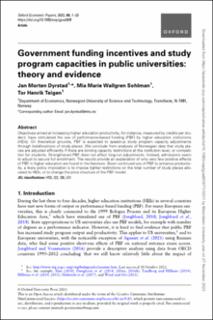Government funding incentives and study program capacities in public universities: theory and evidence
Journal article, Peer reviewed
Published version
Permanent lenke
https://hdl.handle.net/11250/3108296Utgivelsesdato
2023Metadata
Vis full innførselSamlinger
- Institutt for samfunnsøkonomi [1182]
- Publikasjoner fra CRIStin - NTNU [38679]
Sammendrag
Objectives aimed at increasing higher education productivity, for instance, measured by credits per student, have stimulated the use of performance-based funding (PBF) by higher education institutions (HEIs). On theoretical grounds, PBF is expected to speed-up study program capacity adjustments through (re)allocations of study places. We conclude from analyses of Norwegian data that study places are adjusted efficiently if there are binding capacity restrictions at the institution level, or competition for students. Strengthened PBF does not affect long-run adjustments. Instead, admissions seem to adjust to secure full enrollment. The results provide an explanation of why very few positive effects of PBF in higher education are found in the literature. Given continued use of PBF to enhance productivity, a likely policy implication is to impose tighter restrictions on the total number of study places allocated to HEIs, or to change the price structure of the PBF model.

